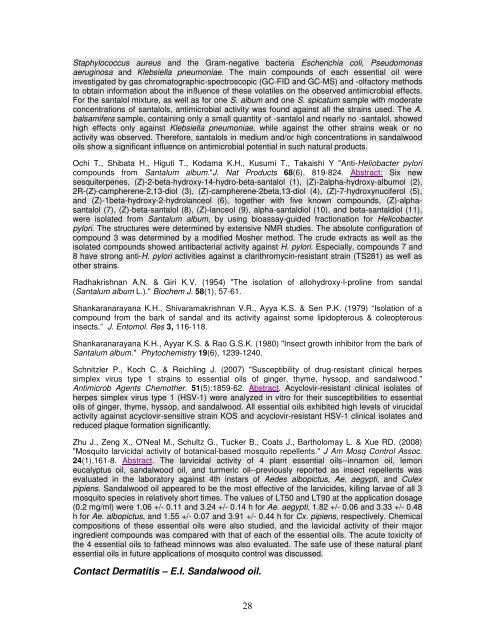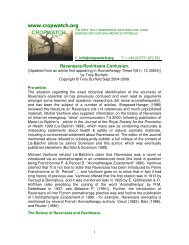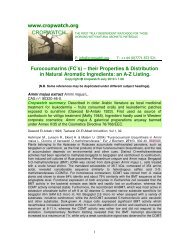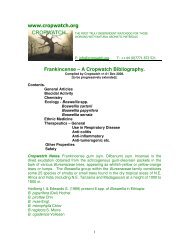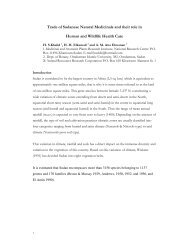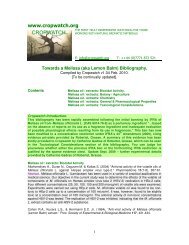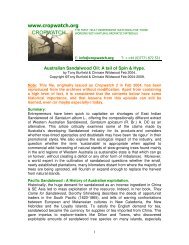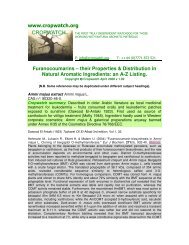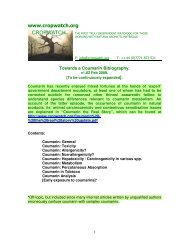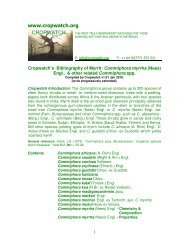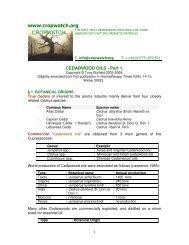Sandalwood Biblio - Cropwatch
Sandalwood Biblio - Cropwatch
Sandalwood Biblio - Cropwatch
Create successful ePaper yourself
Turn your PDF publications into a flip-book with our unique Google optimized e-Paper software.
Staphylococcus aureus and the Gram-negative bacteria Escherichia coli, Pseudomonas<br />
aeruginosa and Klebsiella pneumoniae. The main compounds of each essential oil were<br />
investigated by gas chromatographic-spectroscopic (GC-FID and GC-MS) and -olfactory methods<br />
to obtain information about the inßuence of these volatiles on the observed antimicrobial effects.<br />
For the santalol mixture, as well as for one S. album and one S. spicatum sample with moderate<br />
concentrations of santalols, antimicrobial activity was found against all the strains used. The A.<br />
balsamifera sample, containing only a small quantity of -santalol and nearly no -santalol, showed<br />
high effects only against Klebsiella pneumoniae, while against the other strains weak or no<br />
activity was observed. Therefore, santalols in medium and/or high concentrations in sandalwood<br />
oils show a significant influence on antimicrobial potential in such natural products.<br />
Ochi T., Shibata H., Higuti T., Kodama K.H., Kusumi T., Takaishi Y "Anti-Heliobacter pylori<br />
compounds from Santalum album."J. Nat Products 68(6), 819-824. Abstract: Six new<br />
sesquiterpenes, (Z)-2-beta-hydroxy-14-hydro-beta-santalol (1), (Z)-2alpha-hydroxy-albumol (2),<br />
2R-(Z)-campherene-2,13-diol (3), (Z)-campherene-2beta,13-diol (4), (Z)-7-hydroxynuciferol (5),<br />
and (Z)-1beta-hydroxy-2-hydrolanceol (6), together with five known compounds, (Z)-alphasantalol<br />
(7), (Z)-beta-santalol (8), (Z)-lanceol (9), alpha-santaldiol (10), and beta-santaldiol (11),<br />
were isolated from Santalum album, by using bioassay-guided fractionation for Helicobacter<br />
pylori. The structures were determined by extensive NMR studies. The absolute configuration of<br />
compound 3 was determined by a modified Mosher method. The crude extracts as well as the<br />
isolated compounds showed antibacterial activity against H. pylori. Especially, compounds 7 and<br />
8 have strong anti-H. pylori activities against a clarithromycin-resistant strain (TS281) as well as<br />
other strains.<br />
Radhakrishnan A.N. & Giri K.V. (1954) "The isolation of allohydroxy-l-proline from sandal<br />
(Santalum album L.)." Biochem J. 58(1), 57-61.<br />
Shankaranarayana K.H., Shivaramakrishnan V.R., Ayya K.S. & Sen P.K. (1979) “Isolation of a<br />
compound from the bark of sandal and its activity against some lipidopterous & coleopterous<br />
insects.” J. Entomol. Res 3, 116-118.<br />
Shankaranarayana K.H., Ayyar K.S. & Rao G.S.K. (1980) "Insect growth inhibitor from the bark of<br />
Santalum album." Phytochemistry 19(6), 1239-1240.<br />
Schnitzler P., Koch C. & Reichling J. (2007) "Susceptibility of drug-resistant clinical herpes<br />
simplex virus type 1 strains to essential oils of ginger, thyme, hyssop, and sandalwood."<br />
Antimicrob Agents Chemother. 51(5):1859-62. Abstract. Acyclovir-resistant clinical isolates of<br />
herpes simplex virus type 1 (HSV-1) were analyzed in vitro for their susceptibilities to essential<br />
oils of ginger, thyme, hyssop, and sandalwood. All essential oils exhibited high levels of virucidal<br />
activity against acyclovir-sensitive strain KOS and acyclovir-resistant HSV-1 clinical isolates and<br />
reduced plaque formation significantly.<br />
Zhu J., Zeng X., O'Neal M., Schultz G., Tucker B., Coats J., Bartholomay L. & Xue RD. (2008)<br />
"Mosquito larvicidal activity of botanical-based mosquito repellents." J Am Mosq Control Assoc.<br />
24(1),161-8. Abstract. The larvicidal activity of 4 plant essential oils--innamon oil, lemon<br />
eucalyptus oil, sandalwood oil, and turmeric oil--previously reported as insect repellents was<br />
evaluated in the laboratory against 4th instars of Aedes albopictus, Ae. aegypti, and Culex<br />
pipiens. <strong>Sandalwood</strong> oil appeared to be the most effective of the larvicides, killing larvae of all 3<br />
mosquito species in relatively short times. The values of LT50 and LT90 at the application dosage<br />
(0.2 mg/ml) were 1.06 +/- 0.11 and 3.24 +/- 0.14 h for Ae. aegypti, 1.82 +/- 0.06 and 3.33 +/- 0.48<br />
h for Ae. albopictus, and 1.55 +/- 0.07 and 3.91 +/- 0.44 h for Cx. pipiens, respectively. Chemical<br />
compositions of these essential oils were also studied, and the lavicidal activity of their major<br />
ingredient compounds was compared with that of each of the essential oils. The acute toxicity of<br />
the 4 essential oils to fathead minnows was also evaluated. The safe use of these natural plant<br />
essential oils in future applications of mosquito control was discussed.<br />
Contact Dermatitis – E.I. <strong>Sandalwood</strong> oil.<br />
28


